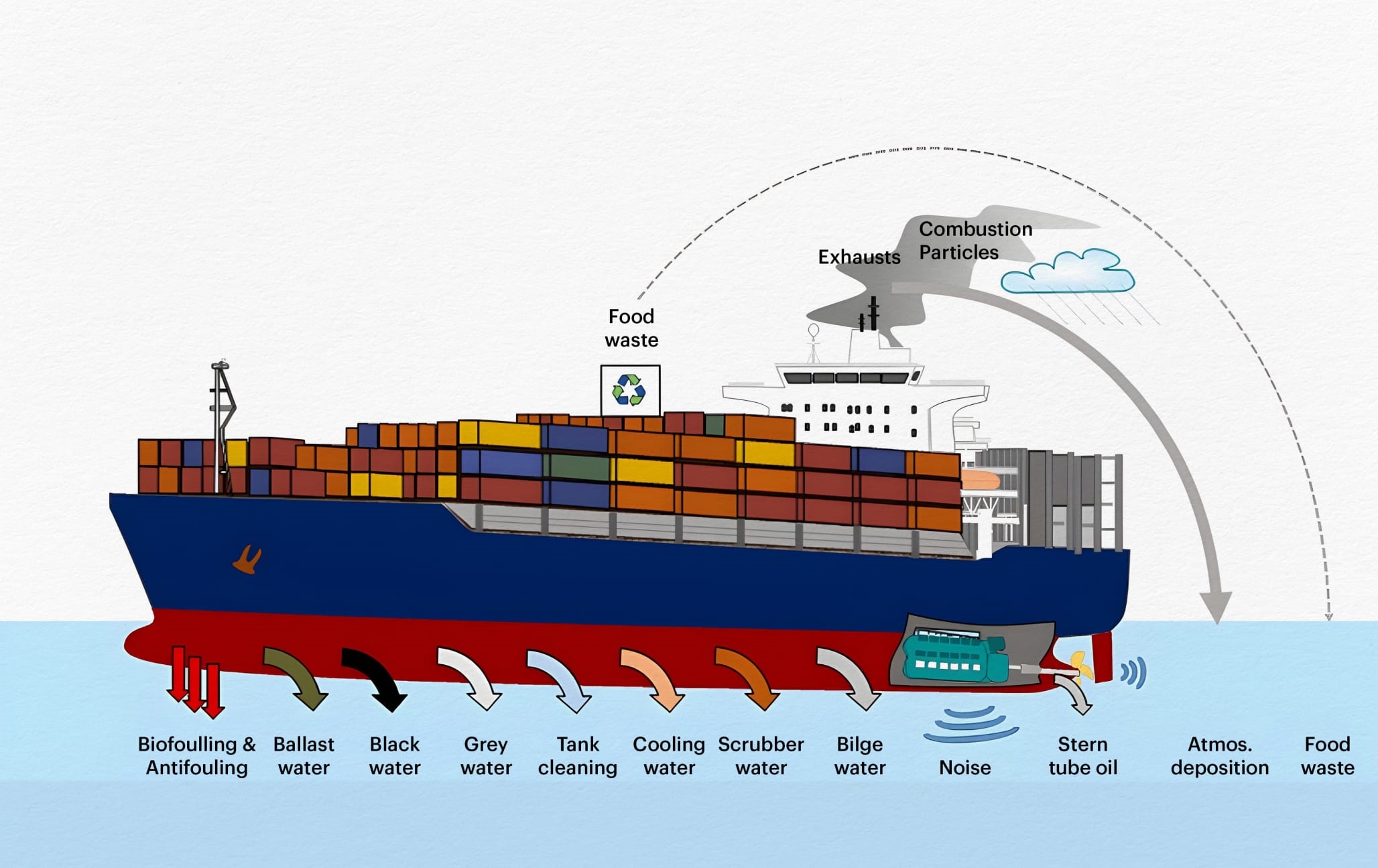The Vital Role of Marine Ecosystems and Our Collective Responsibility
Our planet’s oceans form the foundation of Earth’s life-support system, covering nearly three-quarters of the globe’s surface. These vast waters serve as the planet’s lungs, climate regulator, and breadbasket – generating half of our oxygen, absorbing massive amounts of carbon dioxide, and providing nutritious food for billions. Marine ecosystems represent the most biologically rich environments on Earth, yet remain the least understood and most undervalued.
As human populations expand, we increasingly exploit ocean resources – harvesting fish stocks, extracting fossil fuels, mining minerals, and exploring genetic materials. This growing demand places unprecedented pressure on marine systems. Despite their resilience, oceans now face severe degradation from overuse and pollution.
IMO – the International Maritime Organization – is the United Nations specialised agency with responsibility for the safety and security of shipping and the prevention of marine and atmospheric pollution by ships. IMO’s work supports the UN’s Sustainable Development Goals.
As a specialised agency of the United Nations, IMO is the global standard-setting authority for the safety, security and environmental performance of international shipping. Its main role is to create a regulatory framework for the shipping industry that is fair and effective, universally adopted and universally implemented. In other words, its role is to create a level playing field so that ship operators cannot address their financial issues by simply cutting corners and compromising on safety, security and environmental performance. This approach also encourages innovation and efficiency.
IMO measures cover all aspects of international shipping – including ship design, construction, equipment, manning, operation and disposal – to ensure that this vital sector remains safe, environmentally sound, energy-efficient and secure.
MARPOL Convention
The International Convention for the Prevention of Pollution from Ships, also known as the MARPOL Convention, is the primary international regulation addressing pollution from ships. Adopted in 1973 and modified by the 1978 Protocol, MARPOL aims to minimize the pollution caused by operational and accidental discharges from ships, covering various aspects such as oil, chemicals, sewage, garbage, and air emissions .
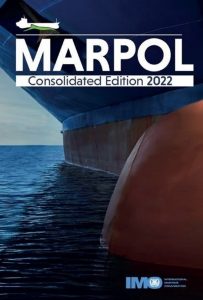
Adoption: 1973 (Convention), 1978 (1978 Protocol), 1997 (Protocol – Annex VI); Entry into force: 1983 (Annexes I and II).
The International Convention for the Prevention of Pollution from Ships (MARPOL) is the main international convention covering the prevention of pollution of the marine environment by ships from operational or accidental causes. The Convention includes regulations aimed at preventing and minimising pollution from ships – both accidental pollution and that from routine operations – and currently includes six technical Annexes. Special Areas with strict controls on operational discharges are included in most Annexes.
Annex I Regulations for the Prevention of Pollution by Oil (entered into force 2 October 1983)
Covers prevention of pollution by oil from operational measures as well as from accidental discharges; the 1992 amendments to Annex I made it mandatory for new oil tankers to have double hulls and brought in a phase-in schedule for existing tankers to fit double hulls, which was subsequently revised in 2001 and 2003.
Annex II Regulations for the Control of Pollution by Noxious Liquid Substances in Bulk (entered into force 2 October 1983)
Details the discharge criteria and measures for the control of pollution by noxious liquid substances carried in bulk; some 250 substances were evaluated and included in the list appended to the Convention; the discharge of their residues is allowed only to reception facilities until certain concentrations and conditions (which vary with the category of substances) are complied with. In any case, no discharge of residues containing noxious substances is permitted within 12 miles of the nearest land.
Annex III Prevention of Pollution by Harmful Substances Carried by Sea in Packaged Form (entered into force 1 July 1992)
Contains general requirements for issuing detailed standards on packing, marking, labelling, documentation, stowage, quantity limitations, exceptions and notifications. For this Annex, “harmful substances” are those substances which are identified as marine pollutants in the International Maritime Dangerous Goods Code (IMDG Code) or which meet the criteria in the Appendix of Annex III.
Annex IV Prevention of Pollution by Sewage from Ships (entered into force 27 September 2003)
Contains requirements to control pollution of the sea by sewage; the discharge of sewage into the sea is prohibited, except when the ship has in operation an approved sewage treatment plant or when the ship is discharging comminuted and disinfected sewage using an approved system at a distance of more than three nautical miles from the nearest land; sewage which is not comminuted or disinfected has to be discharged at a distance of more than 12 nautical miles from the nearest land.
Annex V Prevention of Pollution by Garbage from Ships (entered into force 31 December 1988)
Deals with different types of garbage and specifies the distances from land and the manner in which they may be disposed of; the most important feature of the Annex is the complete ban imposed on the disposal into the sea of all forms of plastics.
Annex VI Prevention of Air Pollution from Ships (entered into force 19 May 2005)
Sets limits on sulphur oxide and nitrogen oxide emissions from ship exhausts and prohibits deliberate emissions of ozone-depleting substances; designated emission control areas set more stringent standards for SOx, NOx and particulate matter. A chapter adopted in 2011 covers mandatory technical and operational energy efficiency measures aimed at reducing greenhouse gas emissions from ships.
Ballast Water Management (BWM) Convention
The International Convention for the Control and Management of Ships’ Ballast Water and Sediments, or the BWM Convention, was adopted in 2004 by the International Maritime Organization (IMO). Its primary objective is to prevent the spread of invasive aquatic species through ships’ ballast water, which can have severe ecological and economic impacts (2). The Convention requires ships to implement approved ballast water treatment systems and adhere to specific discharge standards.
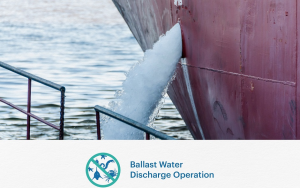
Ballast water is essential to the safe and efficient operation of modern shipping, providing balance and stability to unladen ships. However, it may also pose a serious ecological, economic and health threat due to the transfer of harmful organisms and pathogens in ships’ ballast water tanks. When all factors are favourable, the transferred species may survive to establish a reproductive population in the host environment and may even become invasive. Ballast water discharges by ships can damage the marine environment. Cruise ships, large tankers, and bulk cargo carriers use a huge amount of ballast water, which is often taken on in the coastal waters in one region after ships discharge wastewater or unload cargo and discharge at the next port of call, wherever more cargo is loaded. Ballast water discharge typically contains various biological materials, including plants, animals, viruses and bacteria. These materials often include non-native, nuisance, invasive and exotic species that can cause extensive ecological & economic damage to aquatic ecosystems as well as serious human health problems.
BWM Treaty Requirements – Under the Convention, all ships in international traffic must manage their ballast water and sediments to a certain standard, according to a ship-specific ballast water management plan. All ships have to carry a ballast water record book and an international ballast water management certificate. The ballast water management standards are being phased in over a period of time. New ships must meet the ballast water treatment standard. Existing ships should exchange ballast water mid-ocean, but they will need to meet the ballast water treatment standard by the date of a specified renewal survey. Eventually, most ships will need to install an onboard ballast water treatment system.
Anti-fouling Systems (AFS) Convention
The International Convention on the Control of Harmful Anti-fouling Systems on Ships, or AFS Convention, was adopted in 2001 by the IMO. It aims to prohibit the use of harmful anti-fouling paints on ships, which contain toxic substances such as organotin compounds that can have detrimental effects on marine life (3). The Convention requires ships to use environmentally friendly anti-fouling systems and establishes a mechanism for future control of other harmful substances.
Anti-fouling paints are used to coat the bottoms of ships to prevent sealife such as algae and molluscs from attaching themselves to the hull – thereby slowing down the ship and increasing fuel consumption. To keep ships’ hulls clear of marine growth to ensure maximum performance and to prevent the spread of harmful aquatic organisms and pathogens, the industry uses anti-fouling systems to minimize the build-up of marine life on the hull’s surface. The new Convention defines “anti-fouling systems” as “a coating, paint, surface treatment, surface or device that is used on a ship to control or prevent attachment of unwanted organisms”. In the early days of sailing ships, lime and later arsenic were used to coat ships’ hulls, until the modern chemicals industry developed effective anti-fouling paints using metallic compounds.
These compounds slowly “leach” into the seawater, killing barnacles and other marine life that have attached to the ship. But the studies have shown that these compounds persist in the water, killing sealife, harming the environment, and possibly entering the food chain. One of the most effective anti-fouling paints, developed in the 1960s, contains the organotin tributylin (TBT), which has been proven to cause deformations in oysters and sex changes in whelks. In short, in the past, many of the coatings used in such systems were themselves harmful to the marine environment and more benign coatings needed to be developed to replace them.
Montreal Protocol: Implications for the Maritime Industry and Shipping
The Montreal Protocol on Substances that Deplete the Ozone Layer, adopted in 1987, is a global agreement designed to protect the ozone layer by phasing out the production and consumption of ozone-depleting substances . The maritime industry is affected by this Protocol, as ships often contain refrigeration and air conditioning systems using ozone-depleting substances. The industry is now required to use alternative refrigerants and ensure proper maintenance and disposal of old equipment. These ozone-depleting substances (ODS) chemicals, when released into the atmosphere, damage the stratospheric ozone layer, which serves as Earth’s protective shield against harmful levels of ultraviolet radiation from the sun. Adopted in 1987, the Protocol is one of the few treaties to achieve universal ratification.
The maritime industry and shipping sector are impacted by the Montreal Protocol, as ships often contain refrigeration and air conditioning systems that use ODS, particularly hydrochlorofluorocarbons (HCFCs). These gases are widely used in refrigeration and air-conditioning applications, but they are being phased out under the Montreal Protocol due to their ozone-depleting properties and significant global warming potential (GWP). Developed countries have been reducing their consumption of HCFCs and will completely phase them out by 2020, while developing countries started their phase-out process in 2013 and will continue until 2030. In compliance with the Montreal Protocol, the shipping industry is required to use alternative refrigerants and ensure proper maintenance and disposal of old equipment.
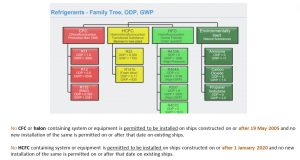
The Montreal Protocol, an international treaty signed in 1987, aimed to phase out the production and consumption of ozone-depleting substances (ODS), such as chlorofluorocarbons (CFCs) and hydrochlorofluorocarbons (HCFCs). The protocol has been successful in achieving its goal, and the ozone layer is showing signs of recovery.
The Kigali Amendment to the Montreal Protocol, agreed upon in 2016, extends the protocol’s scope to include hydrofluorocarbons (HFCs), which are potent greenhouse gases (GHGs) with a high global warming potential (GWP). The amendment aims to phase down the production and consumption of HFCs globally, with developed countries taking the lead in phasing out HFCs by 2019, and developing countries following in later years. The Kigali Amendment primarily targets the refrigeration and air conditioning sectors, as HFCs are commonly used as refrigerants in these systems. However, as mentioned in the statement, some ships also use HFCs in their refrigeration systems. Therefore, the shipping industry may need to transition to alternative refrigerants with lower GWP to comply with the Kigali Amendment’s requirements.
The maritime sector is also affected by the Kigali Amendment, which aims to phase down hydrofluorocarbons (HFCs) – non-ozone depleting alternatives that were introduced to replace CFCs and HCFCs. Although HFCs do not harm the ozone layer, they have high GWPs and contribute to climate change. The Kigali Amendment, which entered into force in 2019, mandates a gradual reduction of HFCs by 80-85% by the late 2040s. To adhere to the Montreal Protocol and its amendments, the maritime industry must reduce its dependency on high-GWP alternatives and increase the adoption of low-GWP, energy-efficient technologies. By doing so, the industry can achieve the Montreal Protocol’s objective of eliminating ozone-depleting substances while simultaneously improving energy efficiency and reducing CO2 emissions, thus providing climate co-benefits.

Kyoto Protocol
The Kyoto Protocol is an international treaty from 1997 that aimed to reduce greenhouse gas emissions and fight global warming. It extended the 1992 United Nations Framework Convention on Climate Change (UNFCCC) and focused on seven major greenhouse gases. The treaty recognized that countries have different abilities to address climate change due to their economic development. As a result, it placed more responsibility on developed countries to reduce emissions since they have historically contributed more to the problem. The Kyoto Protocol came into effect in 2005 and had 192 participating countries in 2020. The Kyoto Protocol applied to the seven greenhouse gases listed in Annex A: carbon dioxide (CO2), methane (CH4), nitrous oxide (N2O), hydrofluorocarbons (HFCs), perfluorocarbons (PFCs), sulfur hexafluoride (SF6), nitrogen trifluoride (NF3).[8] Nitrogen trifluoride was added for the second compliance period during the Doha Round.
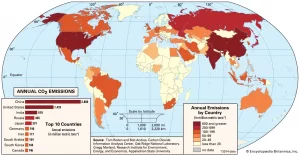
Carbon dioxide emissions
The Kyoto Protocol is an international agreement that was made to reduce greenhouse gases that cause global warming. It committed most developed countries to cut down their emissions, but developing countries were not required to do so. The protocol provided several ways for countries to meet their targets, such as planting trees or investing in less-developed countries. If a country failed to meet their target, they had to pay a penalty. The Kyoto Protocol faced challenges as some of the biggest emitters, like China and the United States, did not sign the agreement. In 2015, the Paris Agreement replaced the Kyoto Protocol and was signed by all countries, including major emitters.
In summary, the Kyoto Protocol does address HFCs as potent GHGs but does not specifically regulate or mandate their use in the maritime industry. The shipping sector may be indirectly affected by the phase-down of HFCs under the Kigali Amendment to the Montreal Protocol.
Hong Kong Convention
The Hong Kong International Convention for the Safe and Environmentally Sound Recycling of Ships, adopted in 2009, aims to ensure that ships are recycled in a manner that protects human health and the environment . The Convention sets out standards for ship recycling facilities, requires ships to maintain an Inventory of Hazardous Materials, and establishes a certification process to ensure compliance.
Upon entry into force of the Hong Kong Convention, ships to be sent for recycling will be required to carry an inventory of hazardous materials, which will be specific to each ship. An appendix to the Convention provides a list of hazardous materials the installation or use of which is prohibited or restricted in shipyards, ship repair yards, and ships of Parties to the Convention. Ships will be required to have an initial survey to verify the inventory of hazardous materials, additional surveys during the life of the ship, and a final survey prior to recycling. Ship recycling yards will be required to provide a “Ship Recycling Plan”, specifying the manner in which each ship will be recycled, depending on its particulars and its inventory. Parties will be required to take effective measures to ensure that ship recycling facilities under their jurisdiction comply with the Convention.
The new Convention balances safety and environmental concerns with the commercial realities of seaborne trade and the ship recycling industry. Following the adoption of the Convention, Member States of IMO will need:
– To initiate work to accede to the Convention at the earliest possible opportunity to expedite its entry into force;
– To initiate action to provide technical assistance to requesting countries without awaiting the Convention’s entry into force; and
– To initiate action, as may be necessary, to ensure the effective implementation and proper enforcement of the Convention when it comes into force.
Prepared by Dr.Reza Karimpour

